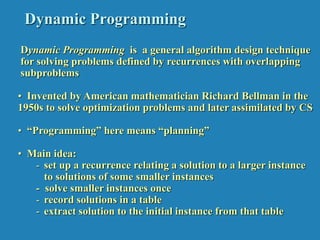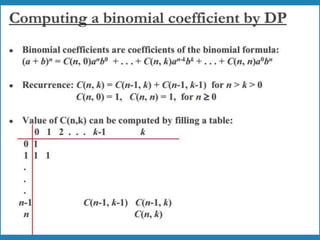Dynamic programming can be used to solve optimization problems involving overlapping subproblems, such as finding the most valuable subset of items that fit in a knapsack. The knapsack problem is solved by considering all possible subsets incrementally, storing the optimal values in a table. Warshall's and Floyd's algorithms also use dynamic programming to find the transitive closure and shortest paths in graphs by iteratively building up the solution from smaller subsets. Optimal binary search trees can also be constructed using dynamic programming by considering optimal substructures.








![Warshall’s Algorithm (recurrence)
On the k-th iteration, the algorithm determines for every pair of
vertices i, j if a path exists from i and j with just vertices 1,…,k
allowed as intermediate
R(k-1)[i,j] (path using just 1 ,…,k-1)
R(k)[i,j] = or
R(k-1)[i,k] and R(k-1)[k,j] (path from i to k
and from k to i
using just 1 ,…,k-1)
i
j
k
{](https://image.slidesharecdn.com/unit4dynamicprogramming-240314172250-61fbdd74/85/Dynamic-Programming-for-4th-sem-cse-students-9-320.jpg)
![Warshall’s Algorithm (matrix generation)
Recurrence relating elements R(k) to elements of R(k-1) is:
R(k)[i,j] = R(k-1)[i,j] or (R(k-1)[i,k] and R(k-1)[k,j])
It implies the following rules for generating R(k) from R(k-1):
Rule 1 If an element in row i and column j is 1 in R(k-1),
it remains 1 in R(k)
Rule 2 If an element in row i and column j is 0 in R(k-1),
it has to be changed to 1 in R(k) if and only if
the element in its row i and column k and the element
in its column j and row k are both 1’s in R(k-1)](https://image.slidesharecdn.com/unit4dynamicprogramming-240314172250-61fbdd74/85/Dynamic-Programming-for-4th-sem-cse-students-10-320.jpg)
![Warshall’s Algorithm
Constructs transitive closure T as the last matrix in the sequence
of n-by-n matrices R(0), … , R(k), … , R(n) where
R(k)[i,j] = 1 iff there is nontrivial path from i to j with only first k
vertices allowed as intermediate
Note that R(0) = A (adjacency matrix), R(n) = T (transitive closure)
3
4
2
1
3
4
2
1
3
4
2
1
3
4
2
1
R(0)
0 0 1 0
1 0 0 1
0 0 0 0
0 1 0 0
R(1)
0 0 1 0
1 0 1 1
0 0 0 0
0 1 0 0
R(2)
0 0 1 0
1 0 1 1
0 0 0 0
1 1 1 1
R(3)
0 0 1 0
1 0 1 1
0 0 0 0
1 1 1 1
R(4)
0 0 1 0
1 1 1 1
0 0 0 0
1 1 1 1
3
4
2
1](https://image.slidesharecdn.com/unit4dynamicprogramming-240314172250-61fbdd74/85/Dynamic-Programming-for-4th-sem-cse-students-11-320.jpg)




![Floyd’s Algorithm (matrix generation)
On the k-th iteration, the algorithm determines shortest paths
between every pair of vertices i, j that use only vertices among
1,…,k as intermediate
D(k)[i,j] = min {D(k-1)[i,j], D(k-1)[i,k] + D(k-1)[k,j]}
i
j
k
D(k-1)[i,j]
D(k-1)[i,k]
D(k-1)[k,j]](https://image.slidesharecdn.com/unit4dynamicprogramming-240314172250-61fbdd74/85/Dynamic-Programming-for-4th-sem-cse-students-16-320.jpg)




![Knapsack Problem by DP
Given n items of
integer weights: w1 w2 … wn
values: v1 v2 … vn
a knapsack of integer capacity W
find most valuable subset of the items that fit into the knapsack
Consider instance defined by first i items and capacity j (j W).
Let V[i,j] be optimal value of such instance. Then
max {V[i-1,j], vi + V[i-1,j- wi]} if j- wi 0
V[i,j] =
V[i-1,j] if j- wi < 0
Initial conditions: V[0,j] = 0 and V[i,0] = 0](https://image.slidesharecdn.com/unit4dynamicprogramming-240314172250-61fbdd74/85/Dynamic-Programming-for-4th-sem-cse-students-21-320.jpg)




![Knapsack Problem by DP (example)
V[i,j]= max(v[i-1, j] , vi + v[i-1, j-wi] if j-wi >=0
v[i-1, j] if j-wi < 0
v[1,1] = 1-2= -1 j-wi<0 = v[0,1]=0
v[1,2]=max(0,12+0)=12
v[2,3]=max(12,10+12)=22
v[3,5]=max(22,20+12)=32
capacity j
0 1 2 3 4 5
0 0 0 0 0 0 0
w1 = 2, v1= 12 1 0 0 12 12 12 12
w2 = 1, v2= 10 2 0 10 12 22 22 22
w3 = 3, v3= 20 3 0 10 12 22 30 32
w4 = 2, v = 15 4 0 10 15 25 30 37](https://image.slidesharecdn.com/unit4dynamicprogramming-240314172250-61fbdd74/85/Dynamic-Programming-for-4th-sem-cse-students-26-320.jpg)
![Knapsack Problem by DP (example)
V[i,j]= max(v[i-1, j] , vi + v[i-1, j-wi] if j-wi >=0
v[i-1, j] if j-wi < 0
v[1,1] = 1-2= -1 j-wi<0 = v[0,1]=0
v[1,2]=max(0,12+0)=12 v[4,5]= max(32, 15+22) =37
v[2,3]=max(12,10+12)=22
v[3,5]=max(22,20+12)=32
capacity j
0 1 2 3 4 5
0 0 0 0 0 0 0
w1 = 2, v1= 12 1 0 0 12 12 12 12
w2 = 1, v2= 10 2 0 10 12 22 22 22
w3 = 3, v3= 20 3 0 10 12 22 30 32
w4 = 2, v4= 15 4 0 10 15 25 30 37](https://image.slidesharecdn.com/unit4dynamicprogramming-240314172250-61fbdd74/85/Dynamic-Programming-for-4th-sem-cse-students-27-320.jpg)
![To know which objects are placed, v[objects, capacity]
If v[4,5] != v[3,5], 4th object is placed else it is not placed
37 != 32 therefore 4th object is placed
Decrease the capacity by the weight of the object
v[3, 5-2]= v[3,3] = v[2,3] , object 3 not placed
v[2,3]!= v[1,3]] 2nd object is placed
v[1, 3-1] = v[1,2] != v[0,2], 1st object is placed
capacity j
0 1 2 3 4 5
0 0 0 0 0 0 0
w1 = 2, v1= 12 1 0 0 12 12 12 12
w2 = 1, v2= 10 2 0 10 12 22 22 22
w3 = 3, v3= 20 3 0 10 12 22 30 32
w4 = 2, v4= 15 4 0 10 15 25 30 37](https://image.slidesharecdn.com/unit4dynamicprogramming-240314172250-61fbdd74/85/Dynamic-Programming-for-4th-sem-cse-students-28-320.jpg)







![DP for Optimal BST Problem
Let T[i,j] be optimal BST for keys ai < …< aj , C[i,j] be minimum
average number of comparisons made in T[i,j], for 1 ≤ i ≤ j ≤ n.
Consider optimal BST among all BSTs with some ak (i ≤ k ≤ j )
as their root; T[i,j] is the best among them.
a
Optimal
BST for
a , ..., a
Optimal
BST for
a , ..., a
i
k
k-1 k+1 j
C[i,j] =
min {pk · 1 +
∑ ps · (level as in T[i,k-1] +1) +
∑ ps · (level as in T[k+1,j] +1)}
i ≤ k ≤ j
s = i
k-1
s =k+1
j
Min Num Comparisons
Best Tree](https://image.slidesharecdn.com/unit4dynamicprogramming-240314172250-61fbdd74/85/Dynamic-Programming-for-4th-sem-cse-students-36-320.jpg)
![DP for Optimal BST Problem (cont.)
After simplifications, we obtain the recurrence for C[i,j]:
C[i,j] = min {C[i,k-1] + C[k+1,j]} + ∑ ps for 1 ≤ i ≤ j ≤ n
C[i,i] = pi for 1 ≤ i ≤ j ≤ n
What table elements are involved?
s = i
j
i ≤ k ≤ j](https://image.slidesharecdn.com/unit4dynamicprogramming-240314172250-61fbdd74/85/Dynamic-Programming-for-4th-sem-cse-students-37-320.jpg)
![goal
0
0
C[i,j]
0
1
n+1
0 1 n
p 1
p2
n
p
i
j
DP for Optimal BST Problem (cont.)
After simplifications, we obtain the recurrence for C[i,j]:
C[i,j] = min {C[i,k-1] + C[k+1,j]} + ∑ ps for 1 ≤ i ≤ j ≤ n
C[i,i] = pi for 1 ≤ i ≤ j ≤ n
s = i
j
i ≤ k ≤ j](https://image.slidesharecdn.com/unit4dynamicprogramming-240314172250-61fbdd74/85/Dynamic-Programming-for-4th-sem-cse-students-38-320.jpg)
![Example: key A B C D
probability 0.1 0.2 0.4 0.3
The left table is filled using the recurrence
C[i,j] = min {C[i,k-1] + C[k+1,j]} + ∑ ps , C[i,i] = pi
The right saves the tree roots, which are the k’s that give the minima
0 1 2 3 4
1 0 .1 .4 1.1 1.7
2 0 .2 .8 1.4
3 0 .4 1.0
4 0 .3
5 0
0 1 2 3 4
1 1 2 3 3
2 2 3 3
3 3 3
4 4
5
i ≤ k ≤ j s = i
j
optimal BST
B
A
C
D
i
j i
j
Tables filled diagonal by diagonal (remember what C[i,j] is).](https://image.slidesharecdn.com/unit4dynamicprogramming-240314172250-61fbdd74/85/Dynamic-Programming-for-4th-sem-cse-students-39-320.jpg)

![Analysis DP for Optimal BST Problem
Time efficiency: Θ(n3) but can be reduced to Θ(n2) by taking
advantage of monotonicity of entries in the
root table, i.e., R[i,j] is always in the range
between R[i,j-1] and R[i+1,j]
Space efficiency: Θ(n2)
Method can be expanded to include unsuccessful searches](https://image.slidesharecdn.com/unit4dynamicprogramming-240314172250-61fbdd74/85/Dynamic-Programming-for-4th-sem-cse-students-41-320.jpg)